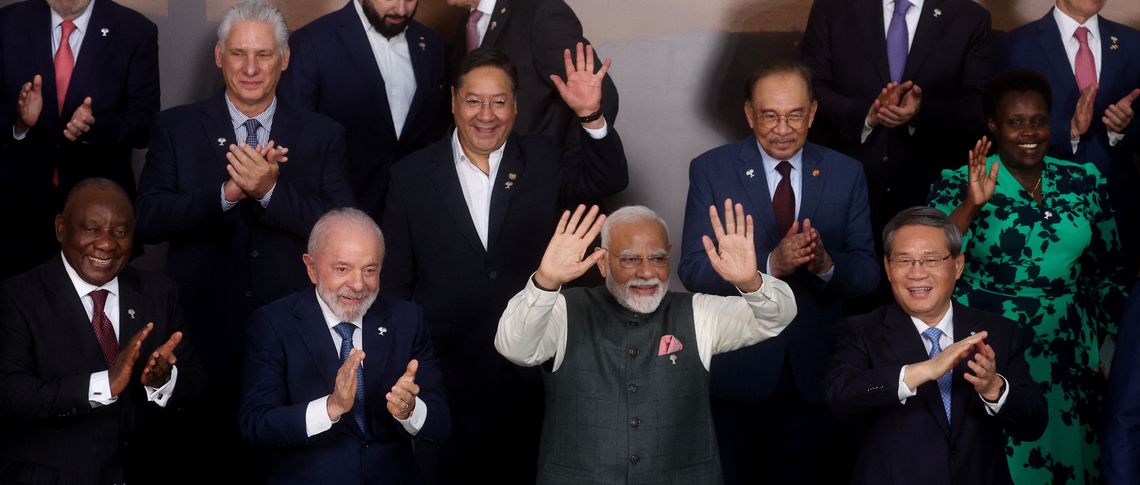From 6 to 7 July, Brazil hosted a BRICS summit in Rio de Janeiro for the fourth time since 2009 — amid growing geopolitical tensions, increasing systemic competition and an erosion of international institutions. In a global environment increasingly characterised by the law of the jungle, many countries in the Global South are experiencing a growing need for alternative multilateral structures. And this is where BRICS appears to be a platform for collective resilience — and as such is becoming increasingly attractive to small and medium-sized powers. Even so, the more acute the global polarisation becomes, the more challenging it will be for BRICS to overcome internal differences and establish itself as an effective actor beyond existing hegemonies.
Last year’s BRICS summit in Kazan, Russia, was clearly aimed at demonstrating the growing political and economic influence of the group of states. This was evident, among other things, in the admission of new full members and the discussion about setting up alternative international payment and trading platforms. It was also intended to show that Moscow is by no means internationally isolated after its aggression against Ukraine. Brazil placed the emphasis on social and economic issues and prioritised the expansion of trade and financial cooperation, in particular through the BRICS Bank and cooperation in the areas of health, climate and artificial intelligence.
Getting down to business
In view of global polarisation and Trump’s threats against the BRICS countries, it was important for the Brazilian government to emphasise before the summit that the bloc is not anti-Western. As Brazilian BRICS Sherpa Mauricio Lyrio stressed, this view is completely wrong. ‘We are not “against”. We are for development, multilateralism, balance and social justice’, assured former Foreign Minister Celso Amorim. To this end, Brazil has presented a series of initiatives. These include the establishment of a ‘Global Alliance to Combat Neglected and Socially Determined Tropical Diseases’ with a focus on South-South cooperation in the health sector, the intensification of cooperation in the areas of infrastructure, taxation and customs, and the implementation of a BRICS climate protection agenda.
While the summit in Russia had a strong demonstrative component, the meeting in Brazil was expected to be more of a working meeting focusing primarily on development policy issues. These low expectations were fuelled by the fact that the BRICS foreign ministers meeting at the end of April ended without a joint statement by the participants. This had triggered speculation about growing differences within the group. Contrary to expectations, the summit adopted a document with strong political statements, which for the first time contains a bold position on the Middle East and Ukraine.
The physical absence of Putin and Xi in Rio was not decisive for the outcome of the meeting. Other positions expressed in the Rio final declaration also largely coincide with those of China and Russia.
It condemns Israel’s military strikes against Iran as a ‘violation of international law and the Charter of the United Nations.’ It also expresses concern about ‘the deliberate attacks on civilian infrastructure and peaceful nuclear facilities’, which it says constitute a violation of international law. The declaration also calls for the West Bank and the Gaza Strip to be placed under the control of the Palestinian Authority and reaffirms the Palestinian people’s right to self-determination, including the establishment of an independent state.
With regard to the war in Ukraine, the BRICS members reaffirmed their hope for a diplomatic solution, but in a separate point ‘strongly condemned’ the Ukrainian attacks on bridges and railway infrastructure in Russia. These statements go significantly beyond the final declaration of the summit in Kazan. Russian attacks on Ukraine are not mentioned in the declaration. Apparently, the physical absence of Putin and Xi in Rio was not decisive for the outcome of the meeting. Other positions expressed in the Rio final declaration also largely coincide with those of China and Russia. On top of that, the BRICS nations also unanimously condemned the terrorist attack on 22 April in the Indian region of Jammu and Kashmir.
This year’s declaration does not indicate any major internal tensions within the BRICS group. Nevertheless, strategic differences remain, and the expansion that has taken place over the past two years brings new challenges. Today, BRICS includes both allied states and competing countries. While some members of the group, such as Russia and Iran, are at loggerheads with the West, others, such as Egypt, receive US military aid, and others, such as the United Arab Emirates, host US military bases. At the same time, there are unresolved territorial disputes between key BRICS members such as India and China, which repeatedly bring relations to the brink of open conflict. Furthermore, Western countries remain undisputed as important sales markets and suppliers of modern technologies for most BRICS countries.
United in diversity
The new BRICS partner states Kazakhstan and Uzbekistan are also pursuing a so-called multi-vector foreign policy: they maintain close relations with Russia and China alongside strategic partnerships with the EU and the US. With their BRICS membership, they are primarily pursuing the goal of diversifying their economic relations in view of the escalating geopolitical tensions between the West and China and Russia. In this context, the accession of Indonesia – a country with good relations with both the West as well as China and Russia, and an important role in the Global South – also represents a strategic gain for the BRICS.
One issue on which all BRICS members and partner countries are largely in agreement is the development of new payment methods to reduce dependence on the US dollar. In practice, India already pays for Russian oil in alternative currencies such as the Indian rupee, the Chinese yuan and the Arab dirham. Two years ago, Brazil and China announced the establishment of a clearing arrangement to facilitate bilateral trade and lending in yuan. And Russia and Ethiopia are considering trading in their national currencies. In its overall strategy for the period 2022–2026, the BRICS bank aims to provide around 30 per cent of its financing in the local currencies of its member states by 2026.
Despite the diversity of the BRICS countries, which also brings with it strategic and security policy differences, economic and development cooperation has been consistently promoted over the past decades. The expansion of the group to 10 members, which now account for over 40 per cent of global GDP, provides a strong foundation for trade, investment and transport, as well as for the development of new economic corridors.
Both the composition of this year’s summit and the final communiqué underscore the growing importance of the Global South for the future direction of the BRICS.
Currently, greater institutionalisation of the group is being considered. One idea is that the BRICS countries could introduce a troika system in which the previous, current and next chair work together to ensure political continuity. Regardless of this, however, the BRICS group is expected to play an important role in articulating common positions among developing countries.
Both the composition of this year’s summit and the final communiqué underscore the growing importance of the Global South for the future direction of the BRICS. The Rio de Janeiro Declaration emphasises the role of the Global South as a ‘driver of positive change’. Finally, Lula’s reference to the BRICS as a vision of non-alignment, formulated at the 1955 conference in Bandung, Indonesia, is noteworthy. This can be interpreted as a signal that the BRICS will not pursue a military component in the foreseeable future.
In the Western perception, two interpretations are currently emerging: either the BRICS agenda and its capacity to act are marginalised, or it is seen as a serious attempt to counter the West’s dominance and the increasing unpredictability of the United States in global politics and economics. The latter is becoming increasingly apparent. The summit in Rio shows that the group is more economically relevant and politically present than ever before. As a platform for the Global South, BRICS could contribute to a rethink of global governance in the medium term. In this regard, the Rio summit was a step towards a multipolar, non-confrontational world order.






